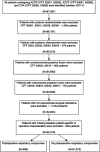Respiratory Compromise After Anterior Cervical Spine Surgery: Incidence, Subsequent Complications, and Independent Predictors
- PMID: 33406919
- PMCID: PMC9609542
- DOI: 10.1177/2192568220984469
Respiratory Compromise After Anterior Cervical Spine Surgery: Incidence, Subsequent Complications, and Independent Predictors
Abstract
Study design: Retrospective cohort study.
Objective: Respiratory compromise (RC) is a rare but catastrophic complication of anterior cervical spine surgery (ACSS) commonly due to compressive fluid collections or generalized soft tissue swelling in the cervical spine. Established risk factors include operative duration, size of surgical exposure, myelopathy, among others. The purpose of this current study is to identify the incidence and clinical course of patients who develop RC, and identify independent predictors of RC in patients undergoing ACSS for cervical spondylosis.
Methods: A large, prospectively-collected registry was used to identify patients undergoing ACSS for spondylosis. Patients with posterior cervical procedures were excluded. Baseline patient characteristics were compared using bivariate analysis, and multivariate analysis was employed to compare postoperative complications and identify independent predictors of RC.
Results: 298 of 52,270 patients developed RC (incidence 0.57%). Patients who developed RC had high rates of 30-day mortality (11.7%) and morbidity (75.8%), with unplanned reoperation and pneumonia the most common. The most common reason for reoperations were hematoma evacuation and tracheostomy. Independent patient-specific factors predictive of RC included increasing patient age, male gender, comorbidities such as chronic cardiac and respiratory disease, preoperative myelopathy, prolonged operative duration, and 2-level ACCFs.
Conclusion: This is among the largest cohorts of patients to develop RC after ACSS identified to-date and validates a range of independent predictors, many previously only described in case reports. These results are useful for taking preventive measures, identifying high risk patients for preoperative risk stratification, and for surgical co-management discussions with the anesthesiology team.
Keywords: ACDF; cervical spine; complications; intubation; respiratory.
Conflict of interest statement
The author(s) declared no potential conflicts of interest with respect to the research, authorship, and/or publication of this article.
Figures
Similar articles
-
Risk Factors for Prevertebral Soft Tissue Swelling Following Single-Level Anterior Cervical Spine Surgery.J Korean Neurosurg Soc. 2023 Nov;66(6):716-725. doi: 10.3340/jkns.2023.0123. Epub 2023 Sep 6. J Korean Neurosurg Soc. 2023. PMID: 37670434 Free PMC article.
-
Hybrid Anterior Cervical Discectomy and Fusion and Cervical Disc Arthroplasty: An Analysis of Short-Term Complications, Reoperations, and Readmissions.Global Spine J. 2021 Oct;11(8):1183-1189. doi: 10.1177/2192568220941453. Epub 2020 Jul 24. Global Spine J. 2021. PMID: 32705903 Free PMC article.
-
Incidence, risk factors, and outcomes of postoperative airway management after cervical spine surgery.Spine (Phila Pa 1976). 2014 Apr 20;39(9):E557-63. doi: 10.1097/BRS.0000000000000227. Spine (Phila Pa 1976). 2014. PMID: 24480959
-
Oropharyngeal Dysphagia after anterior cervical spine surgery: a review.Global Spine J. 2013 Dec;3(4):273-86. doi: 10.1055/s-0033-1354253. Epub 2013 Aug 30. Global Spine J. 2013. PMID: 24436882 Free PMC article. Review.
-
Anterior cervical spine surgery-associated complications in a retrospective case-control study.J Spine Surg. 2017 Sep;3(3):444-459. doi: 10.21037/jss.2017.08.03. J Spine Surg. 2017. PMID: 29057356 Free PMC article. Review.
Cited by
-
Impact of delay extubation on the reintubation rate in patients after cervical spine surgery: a retrospective cohort study.J Orthop Surg Res. 2023 Aug 2;18(1):557. doi: 10.1186/s13018-023-04008-9. J Orthop Surg Res. 2023. PMID: 37528469 Free PMC article. Review.
-
Impact of Enhanced Recovery After Surgery with Neuromuscular Monitoring and Sugammadex on Healthcare Costs and Effectiveness of Recovery in Patients Following Anterior Cervical Spine Discectomy.J Pers Med. 2025 Feb 26;15(3):87. doi: 10.3390/jpm15030087. J Pers Med. 2025. PMID: 40137403 Free PMC article.
-
Risk Factors for Cervical Hematoma After Thyroid Surgery at a Portuguese Hospital: A Retrospective Study.Cureus. 2024 Nov 3;16(11):e72928. doi: 10.7759/cureus.72928. eCollection 2024 Nov. Cureus. 2024. PMID: 39628753 Free PMC article.
-
Postoperative Airway Management after Anterior Cervical Spine Surgery: Retrospective Neurosurgical Multicenter Study.Neurol Med Chir (Tokyo). 2024 May 15;64(5):205-213. doi: 10.2176/jns-nmc.2023-0283. Epub 2024 Apr 4. Neurol Med Chir (Tokyo). 2024. PMID: 38569916 Free PMC article.
-
Postoperative complications of anterior cervical discectomy and fusion: A comprehensive systematic review and meta-analysis.N Am Spine Soc J. 2025 Feb 8;21:100596. doi: 10.1016/j.xnsj.2025.100596. eCollection 2025 Mar. N Am Spine Soc J. 2025. PMID: 40145067 Free PMC article. Review.
References
-
- Findlay C, Ayis S, Demetriades AK. Total disc replacement versus anterior cervical discectomy and fusion: a systematic review with meta-analysis of data from a total of 3160 patients across 14 randomized controlled trials with both short- and medium- to long-term outcomes. Bone Joint J. 2018;100(8):991–1001. doi:10.1302/0301-620x.100b8.Bjj-2018-0120.R1 - PubMed
-
- Saifi C, Fein AW, Cazzulino A, et al. Trends in resource utilization and rate of cervical disc arthroplasty and anterior cervical discectomy and fusion throughout the United States from 2006 to 2013. Spine J. 2018;18(6):1022–1029. doi:10.1016/j.spinee.2017.10.072 - PubMed
-
- McAfee PC, Reah C, Gilder K, et al. A meta-analysis of comparative outcomes following cervical arthroplasty or anterior cervical fusion: results from 4 prospective multicenter randomized clinical trials and up to 1226 patients. Spine. 2012;37(11):943–952. doi:10.1097/BRS.0b013e31823da169 - PubMed
-
- Obermüller T, Wostrack M, Shiban E, et al. Vertebral artery injury during foraminal decompression in “low-risk” cervical spine surgery: incidence and management. Acta Neurochir (Wien). 2015;157(11):1941–1945. doi:10.1007/s00701-015-2594-2 - PubMed
Grants and funding
LinkOut - more resources
Full Text Sources
Other Literature Sources


